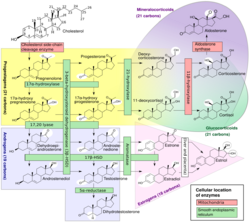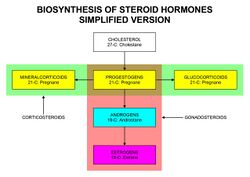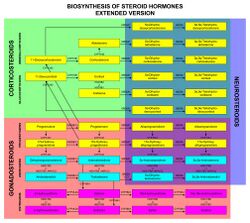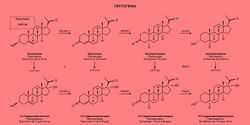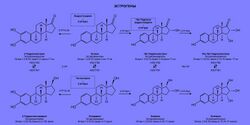Biology:Sex hormone
| Sex hormone | |
|---|---|
| Drug class | |
 | |
| Class identifiers | |
| Synonyms | Sex steroid; Gonadal steroid |
| Use | Various |
| Biological target | Sex hormone receptors |
| Chemical class | Steroidal; Nonsteroidal |
Sex hormones, also known as sex steroids, gonadocorticoids and gonadal steroids, are steroid hormones that interact with vertebrate steroid hormone receptors.[1] The sex hormones include the androgens, estrogens, and progestogens. Their effects are mediated by slow genomic mechanisms through nuclear receptors as well as by fast nongenomic mechanisms through membrane-associated receptors and signaling cascades.[2] The polypeptide hormones luteinizing hormone, follicle-stimulating hormone and gonadotropin-releasing hormone – each associated with the gonadotropin axis – are usually not regarded as sex hormones, although they play major sex-related roles.
Production
Natural sex hormones are made by the gonads (ovaries or testicles),[3] by adrenal glands, or by conversion from other sex steroids in other tissue such as liver or fat.[4]
Types
In many contexts, the two main classes of sex hormones are androgens and estrogens, of which the most important human derivatives are testosterone and estradiol, respectively. Other contexts will include progestogens as a third class of sex steroids, distinct from androgens and estrogens.[5] Progesterone is the most important and only naturally occurring human progestogen. In general, androgens are considered "male sex hormones", since they have masculinizing effects, while estrogens and progestogens are considered "female sex hormones"[6] although all types are present in each sex at different levels.
Sex hormones include:
- Progestogens
- Pregnenolone → Progesterone → Allopregnanedione → Allopregnanolone
- 17α-Hydroxypregnenolone → 17α-Hydroxyprogesterone
- Androgens
- Estrogens
Synthetic sex steroids
There are also many synthetic sex steroids.[7] Synthetic androgens are often referred to as anabolic steroids. Synthetic estrogens and progestins are used in methods of hormonal contraception. Ethinylestradiol is a semi-synthetic estrogen. Specific compounds that have partial agonist activity for steroid receptors, and therefore act in part like natural steroid hormones, are in use in medical conditions that require treatment with steroid in one cell type, but where systemic effects of the particular steroid in the entire organism are only desirable within certain limits.[8]
See also
- List of investigational sex-hormonal agents
- Effects of hormones on sexual motivation
- Sex hormone therapy
References
- ↑ Guerriero, G (April 2009). "Vertebrate sex steroid receptors: evolution, ligands, and neurodistribution.". Annals of the New York Academy of Sciences 1163 (1): 154–68. doi:10.1111/j.1749-6632.2009.04460.x. PMID 19456336. Bibcode: 2009NYASA1163..154G.
- ↑ Thakur, MK; Paramanik, V (2009). "Role of steroid hormone coregulators in health and disease". Hormone Research 71 (4): 194–200. doi:10.1159/000201107. PMID 19258710. http://www.karger.com/Article/Pdf/201107.
- ↑ Brook, CG (1999). "Mechanism of puberty". Hormone Research 51 Suppl 3 (3): 52–4. doi:10.1159/000053162. PMID 10592444.
- ↑ Catherine Panter-Brick; Agustín Fuentes. "Glossary". Health, Risk, and Adversity - Volume 2 of Studies of the Biosocial Society. Berghahn Books, 2011. p. 280.
- ↑ "An Overview Of Sex Hormones" (in en). 2022-06-24. https://www.news-medical.net/health/An-Overview-Of-Sex-Hormones.aspx.
- ↑ ElAttar, TM; Hugoson, A (1974). "Comparative metabolism of female sex steroids in normal and chronically inflamed gingiva of the dog". Journal of Periodontal Research 9 (5): 284–9. doi:10.1111/j.1600-0765.1974.tb00683.x. PMID 4281823.
- ↑ "Effect of endogenous and synthetic sex steroids on the clearance of antibody-coated cells". https://journals.aai.org/jimmunol/article-abstract/141/9/2959/21053/Effect-of-endogenous-and-synthetic-sex-steroids-on.
- ↑ Copland, JA; Sheffield-Moore, M; Koldzic-Zivanovic, N; Gentry, S; Lamprou, G; Tzortzatou-Stathopoulou, F; Zoumpourlis, V; Urban, RJ et al. (June 2009). "Sex steroid receptors in skeletal differentiation and epithelial neoplasia: is tissue-specific intervention possible?". BioEssays 31 (6): 629–41. doi:10.1002/bies.200800138. PMID 19382224.
External links
- Sex+Steroid+Hormones at the US National Library of Medicine Medical Subject Headings (MeSH)
 |
